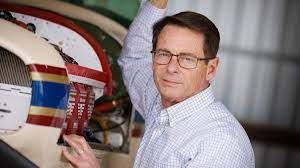TRAINING FOR HEALTH
AGING AIRPLANES, AGING PILOTS
By Thomas B Haines,
Former Senior Vice President
of Communications & Outreach, AOPA


For years one of the major concerns in the general aviation community was the aging fleet. Our armada of some 160,000 light airplanes averages more than 45 years old.
Time, however, has shown that many of those concerns were baseless. We don’t see airplanes falling out of the sky because of age-related issues. Well-maintained airplanes continue to soldier on, especially those without pressurization and those kept corrosion-free.
Today, the bigger concern seems to be on aging aviators. And, as with aging airplanes, the concerns often seem to be without merit. Studies from the AOPA Air Safety Institute and others show that pilots well into their 70s, and some even beyond that, continue to perform well and have accident rates no different than those of younger pilots. Data show that pilot incapacitation accidents continue to be very rare.
Most pilots know that, but apparently the insurance underwriters didn’t get the memo. Daily, here at AOPA, we hear from pilots who at age 69 were insurable for reasonable rates, but on the day they turned 70 their insurance premiums either went up dramatically or they were not considered insurable at all. A recent AOPA survey of 30,000 pilots demonstrates that those over age 70 tend to fly more and hold more advanced ratings than younger pilots, and they do so safely. In fact, over the past five years, there has been no difference in the safety records between those older than 70 and those younger.
For the most part, the insurance underwriters have been unresponsive to AOPA’s requests for data to support their intuition that somehow older pilots represent a higher risk.
Overall, the aviation insurance industry is in a hardened market—premiums across the board have gone up in the past couple of years, but older pilots have been hit especially hard. This insurance business cycle will eventually change, and premiums will at least stabilize or come down for most, if not all, pilots, but the waiting can be agonizing. For some it will, sadly, mean the end of their flying years.
The best way to mitigate the increases is to take steps to remain proficient and healthy, the former being easier than the latter.
I recently participated in a Bonanza and Baron Pilot Training (BPT) program weekend in Norfolk, Virginia. BPT is an organization of highly experienced instructors who conduct weekend seminars around the country to train Beechcraft pilots. I’ve been to numerous of their sessions over my decades of Bonanza ownership and always find the courses helpful and reinvigorating. In most cases, you will leave the weekend with a current flight review and instrument proficiency check, a fistful of FAA Wings credits, and a certificate to show your insurance company that you went to the trouble to participate in an in-depth training program—valuable, regardless of your age.
One of the sessions during the ground school portion of the weekend was conducted by Greg Ricca, an Arkansas-based Baron owner and CFI who is also a neurosurgeon. He led a fascinating discussion about the impact of aging on the human body and what we can do to mitigate it. Those of us on the backside of middle age will relate to his point that hearing and sight deteriorate with age, with a 60-year-old requiring about three times the light to see an image that a 20-year-old requires. Men tend to lose their ability to hear high frequencies sooner than women. But, in both cases, there are ways to minimize the impact of such things in our lives—turn up the lights and, if necessary, get a hearing aid, most of which are very unobtrusive these days.
Ricca emphasized the importance of diet and exercise to maintain our ability to fly safely. A Mediterranean-type diet high in vegetables and certain healthy oils can help promote longevity. Vitamin D3 is especially important for brain health. Ricca recommends two to four cups of coffee a day and/or green or white tea. The caffeine is not necessary, but it doesn’t hurt either. It’s the antioxidants and other components that help the brain. And, after the flight, one or two alcoholic drinks a day can have health benefits for many, as well. Exercising the muscles in the lower extremities and the large muscle groups can lead to neuron synthesis, which can result in repairing of the brain, something once thought not possible. Socialization and exercising the brain as well as the muscles will help assure years of safe flying.
As it turns out, our mechanical flying machines and our organic bodies may be more alike than we might think. Lots of exercise and good maintenance can keep both going for many more decades to come.
Tom Haines, former AOPA senior vice president of communications and outreach, has flown more than 100 models of airplanes over the past 40 years.
This article, which was originally featured in the January 2022 edition of AOPA Pilot Magazine, is reprinted with permission from Aircraft Owners and Pilots Association [AOPA].



